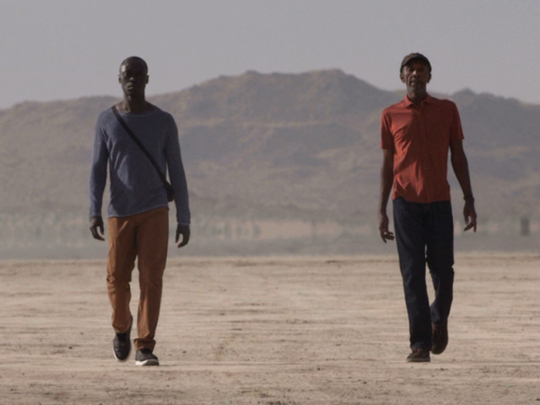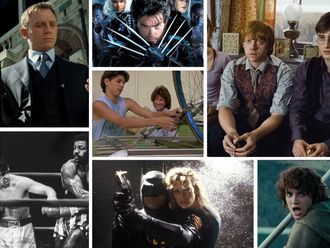
Bill Viola is well known for using video as a medium to create powerful and profound artworks. Over the last four decades, he has won many prestigious awards for his work, including the Praemium Imperiale. The American artist takes inspiration from Eastern and Western art, Zen Buddhism, Islamic Sufism and Christian mysticism, to express fundamental truths about the human condition. His philosophical and spiritual videos address themes that have universal resonance, inviting viewers to contemplate their own emotions, memories and understanding of life.
A selection of Viola’s pioneering video works is being exhibited for the first time in the UAE in an exhibition at Leila Heller Gallery, titled The Vast: Mirrors of the Mind. These include works from his Sufi inspired Transfiguration series, created between 2007 and 2008; the Mirage series from 2012, featuring desert based mediations on existence; and the meditative Water Portraits or Dreamers series from 2013.
The show, curated by Brooke Lynn McGowan, highlights the thematic relationships in Viola’s work, such as his portrayals of the desert and water as metaphors for the exploration of the voyage of life and death, and of the conscious and unconscious mind.
Viola’s artworks reflect his quest to represent the limits of perception at the threshold between the conscious and unconscious mind. He describes it as a desire “to go to a place that seems like it is at the end of the world — a vantage point from which one can stand and peer out into the void where all becomes strange and unfamiliar. You have reached the edge, and you finally realise that the void is yourself. It is like a mirror in your mind.”
For the artist, the vast, arid, harsh desert landscape is one such mirror of the mind. He sees it as a point of contact between the physical and the psychological, producing mirages, that are ‘hallucinations of landscape offering the experience of being in someone else’s dream’. His exploration of the layers of reality and illusion in the physical expanse of the desert in his Mirage series from 2012, is an allegorical reference to a deeper exploration of human existence.
For instance, in Walking on the Edge, presented in this show, he seeks to investigate the limits of our understanding of the position of the human in the natural order, both physically and metaphysically. The video represents the inevitable separation of father and son as they take separate paths in their life’s journey. It begins with two men arriving in the desert under a turbulent sky. Appearing from opposite ends of the screen, they walk towards the viewer moving closer to each other, until they are walking side by side. But gradually, they cross paths and start moving apart, until they disappear on opposite ends of the frame.
Through this simple, yet profound visual, Viola represents the inner and outer journey across the landscape of the mind, represented by the desert. In this voyage through consciousness towards our perception of the exterior world, the artist reaches the edge he seeks, where both the desert and the self are the void.
Like the desert, another strong and recurring motif in Viola’s work is water. It appears as a symbol of the passage of birth, death and renewal in his moving videos from the Transfigurations and Water Portraits series.
The artist created the Transfiguration series in 2007/2008 to complement his installation for the 52nd Venice Biennale titled, Ocean Without a Shore. Viola took this title from 13th century Andalusian Sufi mystic Ibn Arabi’s words, “The self is an ocean without a shore. Gazing upon it has no beginning or end, in this world and the next.” The two works in the show from this series, Lenny and Howard depict solitary figures on an eternal voyage.
In each video a grainy, black and white figure appears in the distance, then breaks through a wall of water that becomes visible only after he passes through it, to emerge in full colour before the viewer. This sequence is repeated in an endless cycle. The artist describes this journey as encounters at the intersection of life and death, where human beings are born, but realising that their existence in the physical world is finite, they eventually turn away from material existence to return from where they came, in an endless cycle of birth, death and rebirth. Thus, in these works, the water signifies both life and death, in an infinite journey of renewal.
Unlike the endless journeys in the other series, there is an uncanny stillness in the haunting images of the Water Portraits series, three of which are presented in this exhibition. Accompanied by the sound of gently flowing water, the three videos, Sharon, Blake’s Dream, and Madison, portray a woman, a young man, and a little girl respectively completely submerged under water. Their eyes are closed, and they are still, moved only by the gentle rippling of the current. The melancholic and meditative faces of these submerged ‘dreamers’, portray the liminal state of sleep, between the conscious and the unconscious, where stillness, and the water that surrounds them, represents both life and death, and the root of all life.
The Vast: Mirrors of the Mind has been organised in collaboration with Bill Viola Studio and Blain|Southern. It will run at Leila Heller Gallery in Dubai until April 22.











